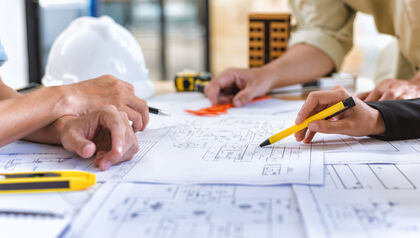Architects, engineers and in some cases, contractors can receive financial benefits for energy-saving designs through Internal Revenue Code Section 179D.
Significant portions in the tax code—1031 Exchanges, carried interest, capital gains, and more—are front of mind for many businesses due to potential changes. A move in late 2020 by Congress made permanent a tax strategy that is often overlooked by architect and engineering firms.
On December 28, 2020, the Section 179D Commercial Building Energy-Efficient Tax Deduction was made a permanent part of the U.S. tax code in the Consolidated Appropriations Act of 2021. The deduction provides tax benefits for qualifying architecture, engineering, and construction companies on certain designed projects for government-owned buildings achieving energy-efficiency targets after construction is complete.
Building owners and operators have been incentivized to include energy-saving designs in their buildings for decades, and now design and construction firms can receive extra financial benefits for their part in a project through Section 179D.
Before claiming the deduction, however, A&E firms should note some key rules and regulations.
What is the Section 179D Tax Deduction?
Through claiming a Section 179D deduction, companies can receive as much as $1.80 per square foot when making efficiency improvements above certain energy thresholds to commercial buildings. The $1.80 per square foot deduction also now increases slightly each year to account for inflation. Currently in 2022 at a $ 1.88 per square foot.
With the permeance of Section 179D architecture, engineering, and construction companies can claim the deduction beyond 2021—letting them plan for and generate significant tax savings from construction projects for government entities.
Who Can Claim a Section 179D Deduction and Applicability to A&E Firms?
The Section 179D deduction can be allocated to engineering, architecture, and construction entities that are responsible for the design components of government-owned, energy-efficient buildings.
Because the owners of these public buildings are nontaxable entities, the deduction is then passed on to the primary designers of the buildings—in this case, engineering, architecture, construction entities, and energy service providers that qualify as designers. The purpose of the deduction is to incentivize designers of government-owned buildings to utilize energy efficient systems and components within the construction projects.
An entity is considered responsible for the building’s design components if it creates the technical specifications for a building. Any entity that merely installs, repairs, or maintains a property does not meet the definition of a designer for the purposes of this deduction.
What Special Aspects Apply to Architects and Engineers?
Architecture and engineering firms have primary responsibility for the design of energy efficient properties and technical specifications. As result, they are likely to qualify for the Section 179D deduction for improvements made to any of the following categories:
- Building envelope
- Heating, ventilation, and air conditioning (HVAC) system
- Lighting system
- Fully replaced domestic hot water heaters
In some instances, the construction contractor may qualify for the Section 179D deduction if they have input in the design or are obligated to participate in the design based on their contract terms.
For example, contractors engaged on a design-build contract with a government entity are more likely to qualify for the Section 179D deduction than if they are only operating as a general contractor.
Will Claiming Section 179D Deductions Trigger an IRS Audit?
On May 26, 2022, The Section 179D IRS Practice Unit released a knowledge-based document or the ATG that outlines the steps the IRS would take when auditing Section 179D studies, so it is important for designers to carefully review those guidelines. Please refer to our recent podcast: Leveraging the 179D Energy Tax Deduction for Architecture and Engineering Firms.
Claiming the deduction as a designer of government-owned buildings will not automatically trigger an audit from the IRS, but it is important to follow the appropriate steps to determine qualification for the deduction. The IRS Large Business and International division (LB&I) has included Section 179D in its list of so-called practice units, which provides a framework for designers that might be eligible to take the deduction.
Why is a Study Needed to Claim a 179D deduction?
A company claims the Section 179D deduction in the same tax year as when the building is placed in service. If the entity meets the requirements of the Section 179D study, it can report the deduction on its current-year tax return. If the deduction was not applied on a timely-filed tax return, there are avenues to claim the deduction retroactively. Designers can look back three open tax years to claim the deduction on amended tax returns. Building owners can reach back to apply Section 179D results as far back as the 2006 tax year through an accounting method change.
The deduction can now be up to $1.88 per square foot for 2022 projects, adjusted for inflation. A company that is claiming the deduction for only one system, the HVAC system for example, would claim the credit at $.63 per square foot.
In a Section 179D study, a qualified third party—separate from the designer taking the Section 179D deduction—uses IRS-approved energy software to model the energy performance of the building and improvements.
The energy model then compares the building’s performance with a reference building that meets relevant energy and power cost requirements, according to standards set by the American Society of Heating, Refrigerating, and Air-Conditioning Engineers (ASHRAE). The third-party also completes a physical site visit of the facility.
The qualified third party must be a contractor or professional engineer (PE) licensed in the state where the building is located. The third party must review the results of the energy model and verify the improvements meet the applicable energy-savings thresholds using the ASHRAE standards.
They must also sign a certification document for the Section 179D deduction stating they have examined the energy model and support the allocation of the deduction to its respective designer.
The Section 179D deduction can provide a significant cash-flow opportunity for architecture, engineering, and construction entities. Companies pursuing the 179D deduction should consult with Cherry Bekaert’s Tax Credits and Incentives advisory practice to ensure they are maximizing the energy efficient deduction.
Cherry Bekaert’s Professional Services Industry team is comprised of accounting and tax advisors and business strategists, technologists and analysts who have extensive A&E firm industry experience and keen business acumen. Our team of advisors continue to share innovative ideas, industry trends, regulatory compliance, and best practices to guide A&E firms forward. Watch for future podcasts, webinars and articles in the coming months specifically tailored to the unique tax, financial, and business needs of A&E firms, to keep you informed on proven solutions that can have a positive financial and operational impact on your business.





